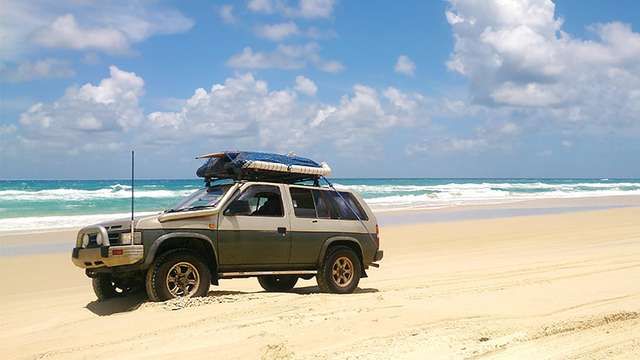- tyres
Top tyres for beach driving

Updated 10 Aug 2021
Bruce McMahon

The most important four-wheel drive tool when heading to the beach? Arguably it’s the humble tyre gauge.
Australian drivers, and four-wheel drivers in particular, ask a great deal from tyres.
Those four corners of rubber need to ride nicely in the dry, hang on in the wet and corner at speedway speeds _ then head off into the backblocks and clamber over ragged rocks and push on through hot sands.
Or plough through a snow drift and up a mud-soaked slope.
In many off-road situations, it’s tyre pressures which can make the difference between looking like a hero or looking like a dunce.
Over-inflation is often the problem, whether running over Flinders Range gibbers or charging up the sands of Fraser Island.
Over sharp gravel, too much air can lead to tread damage; too much air pressure when beach driving will make for hard going and bogging.
(Note: While some argue more air means better fuel economy and premium load-carrying, best to start by sticking with the manufacturer’s recommendations, usually found on a placard inside the vehicle’s door well; after all, the manufacturer worked out the rest of the engineering parameters.)
Which tyres are best for beach driving?
The better tyres for sand work are the bog-standard highway terrain or all-terrain tyres - the first are widespread on today’s Sports Utility Vehicles, all-terrain tyres are a touch more aggressive and adventurous in tread patterns.
Those more agro mud terrain tyres, with lumps and chunks in all directions, are better suited to mud and rocks.
The importance of tyre pressure
The better tyre pressures for sand?
Most like to go for 18psi or about 1.24bar.
This means there’s still scope for driving at posted speed limits on the beach while being able to deal with softer patches of sand.
The good thing is it’s always possible to go lower if the going becomes extra difficult, down to say 15psi.
Still in trouble and now bogged to the axle?
Take a little more air out but be extra careful once down around 12psi (or lower) and back on the hard stuff; it may not take too much of a hard turn to pop a tyre off the rim.
The effect of lowering tyre pressures isn’t to balloon out the tyre, rather it’s about lengthening the tread _ the bit that does all the work on all manner of surfaces, that interfaces directly with the road and track conditions - for more contact with the surface.
Tools of the trade
A tyre gauge - and a small stick or biro top to depress the valve - is an important tool for sand driving.
There are also tyre deflators which can be set to a desired pressure and screwed into the valve stem for hands-free deflation.
Best to add a snatch-um strap, shovel and maybe a set of traction mats for stress-free beach drives.
Four-wheel drivers should have tyres rotated and balanced, plus a front-end alignment, on a regular basis.
Off-roading can put wheels and tyres out of whack and not working to maximum performance.

Written By
Bruce McMahon
Bruce McMahon is a Queensland-based journalist who’s spent a fair slice of his career dealing with automotive matters.
His first car was a 1949 Riley Roadster, followed by a mix of machinery from Porsches to Jeeps, Alfa Romeos and Range Rovers through to the current four-wheel drive Mazda ute.
He’s driven the Nurburgring and the Tanami Tracks.